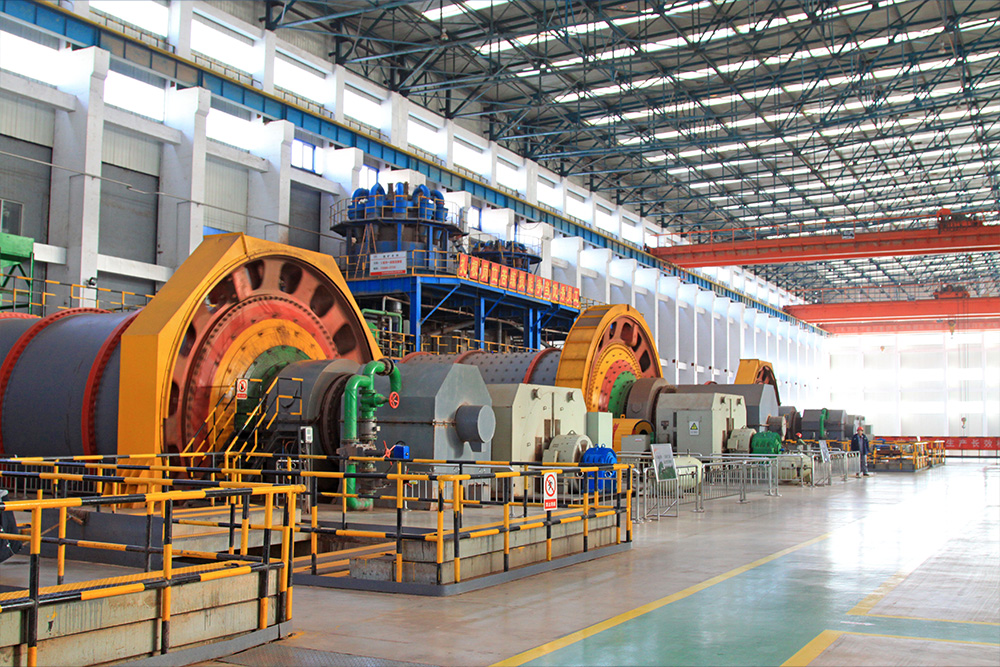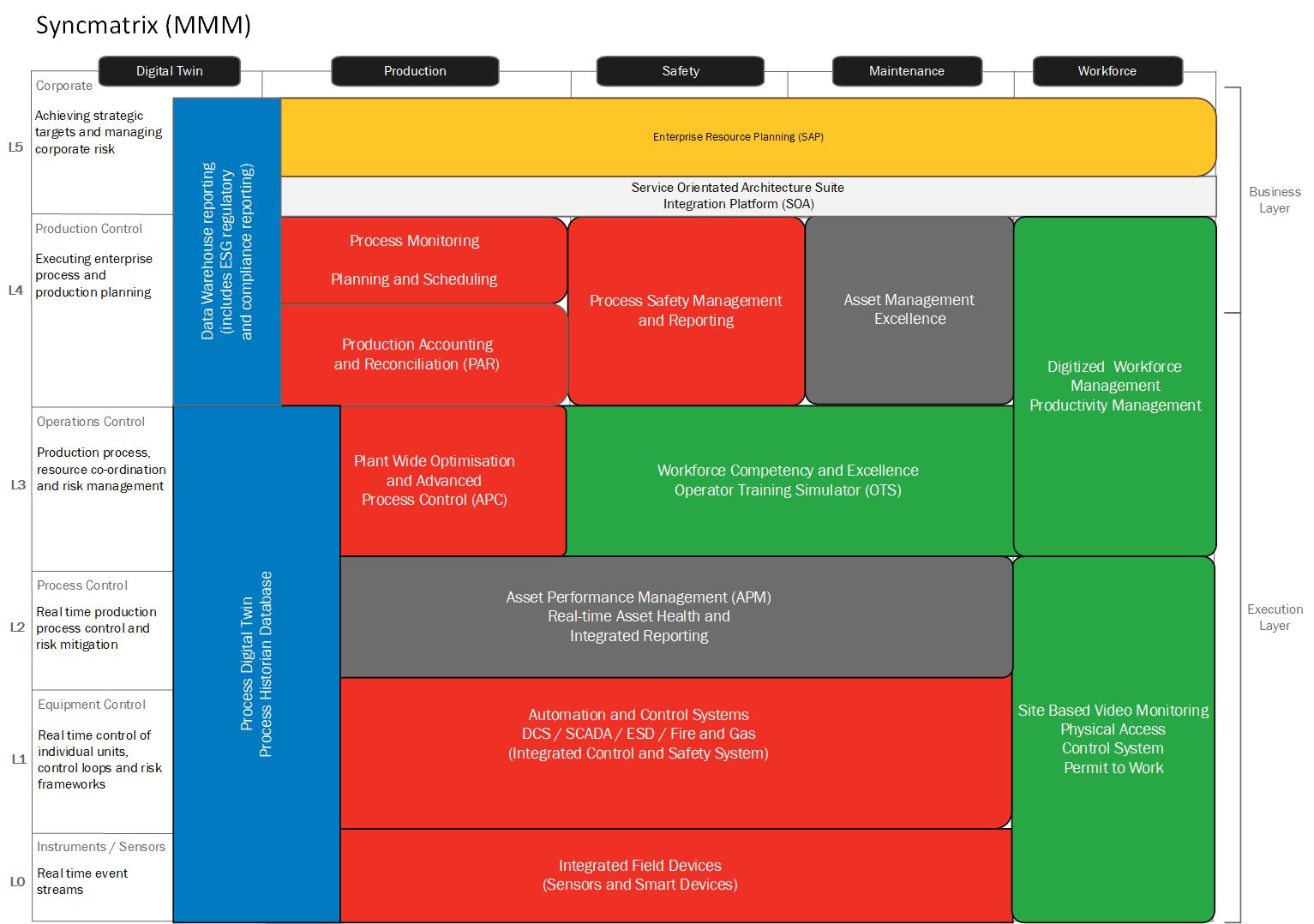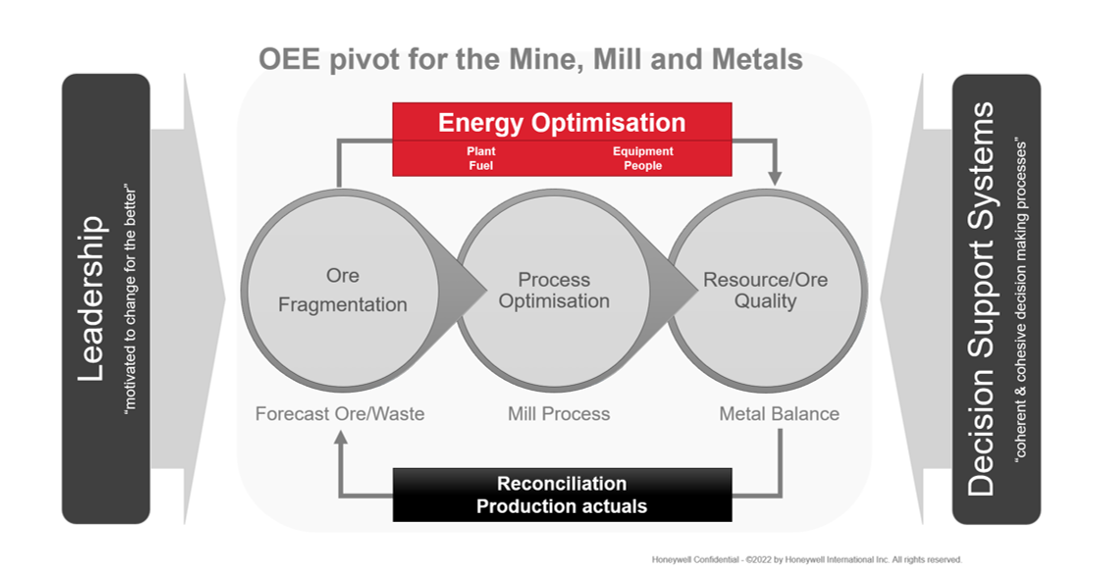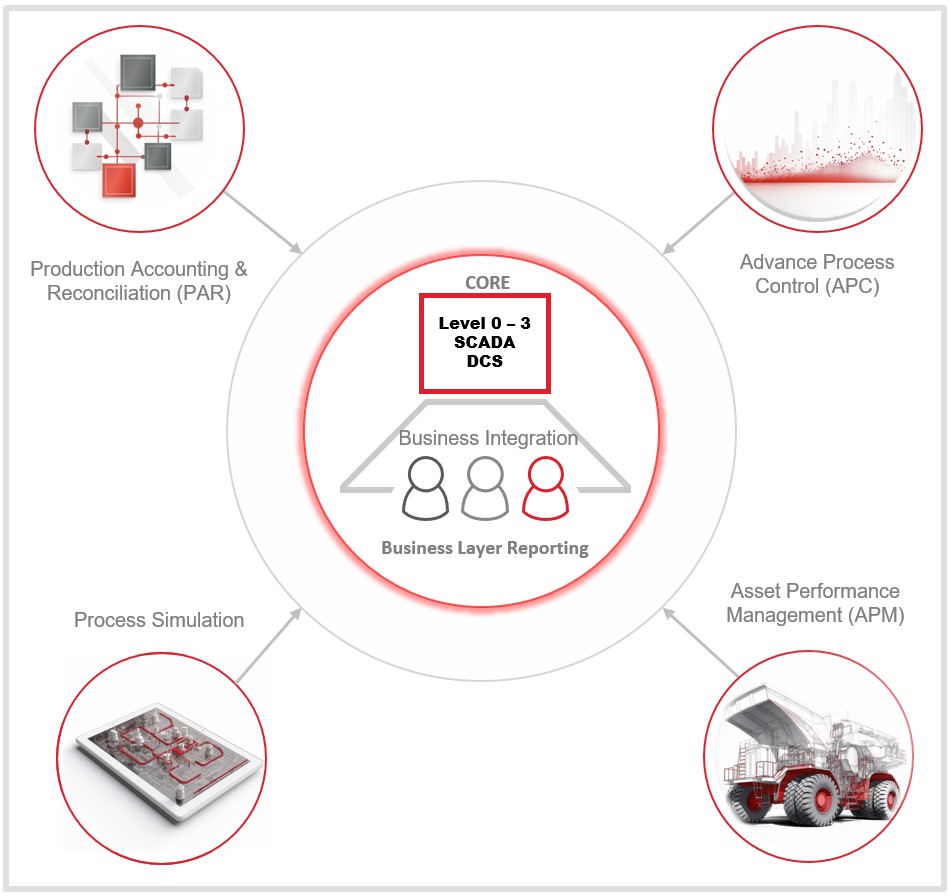Unveiling OEE 2.0 - Overall Energy Effectiveness in Mining Operations
Maximizing Yield through a Holistic Approach

The Age-Old Mining Dilemma
In the world of mining, a persistent dilemma echoes through the corridors of mine and mill operations. Mines strive relentlessly to maximize tonnage, while mills demand unwavering quality assurance. This centuries-old problem, at the core of the mining industry, has long eluded a solution, leaving mining companies wrestling with a challenge that defines their existence.
The Purdue Model as the Bridge
What if we dared to reshape this narrative and embrace the energy equation as the defining measure for mine and mill operations? Today, environmental, social, and governance (ESG) drivers demand less energy for mining operations; conversely, the variation in ore grade shows the most significant contribution to the variability of specific energy for mill processes.
Enter the Purdue Enterprise Reference Architecture (PERA), a time-tested framework rooted in industrial automation and control systems (IACS). PERA offers a standardized approach for designing, implementing, and managing industrial processes and systems, placing energy optimization at its heart. While we often witness system unification at the corporate level, it seldom permeates to Level 0 through Level 3 in mining operations. PERA offers a structured approach with an architectural blueprint capable of bridging the chasm, allowing for harmonized process optimization and energy management.
Navigating the Convergence Challenge
The journey toward realizing the full potential of the Purdue Enterprise Reference Architecture (PERA) in the mining industry is not without its hurdles. The convergence of information technology (IT) and operational technology (OT) presents a formidable challenge. IT systems, designed for data processing and analytics, grapple with the intricacies of server and network architecture needed to analyze and consolidate the complex data sets that originate at the machine level, the heart of OT. Requisite server and network infrastructure must align with the layers associated with safety systems and protocols vital for interpreting data sets originating in the realm of OT. This disconnect between the operational layers and corporate IT creates a substantial hurdle, making the convergence of IT and OT a pressing problem - without crucial stakeholder engagement. It is such that the energy equation, the fulcrum for both mine and mill operations, cannot be fully optimized without overcoming this convergence. Yet, we have the blueprint for progress through PERA's structured methodology.
Figure 1 provides the overarching technology layering from Level 0 (field device) to Level 5 (corporate level), known collectively as a Syncmatrix (MMM).

Figure 1: MMM Technology Syncmatrix
OEE 2.0 Pivot - Maximizing Overall Energy Effectiveness (OEE) - The Syncmatrix for MMM
The Syncmatrix offers an illustrative example and is the blueprint for overall energy effectiveness (OEE) as a transformative measure. It encompasses the entire spectrum of mining and milling operations, from the initial stages of rock fragmentation to the intricacies of process optimization and the assurance of resource and ore quality. It is within this holistic framework that OEE finds its purpose.
Within the Syncmatrix, two central systems emerge as the cornerstones of OEE optimization: Supervisory control and data acquisition (SCADA) and distributed control systems (DCS). These systems are the architectural backbone upon which OEE is built, ensuring integration capability across the mining supply chain.
SCADA - Orchestrating Data: SCADA systems, nestled within the Purdue model, stand as the commanding nerve center of modern mining operations. They are the guardians of data, diligently collecting and managing information from sensors, instruments, and the various components of the mill's machinery. SCADA's real-time visibility into mill operations gives operators a comprehensive view of processes, equipment status, and performance metrics. This integration ensures the mill operates within desired parameters, maximizing process efficiency—a vital element of OEE optimization.
DCS - Precision Control: Distributed control systems (DCS) assume a central role within the Purdue model. DCS systems are the command center for precision control in milling operations. They excel in managing the intricacies of automation, ensuring that equipment and processes function harmoniously and efficiently.
One of DCS's key attributes is its capacity for advanced process control (APC), precisely aligning with the Purdue model's efficiency goal. Through advanced algorithms and predictive modeling, DCS optimizes processes in real time, striving to achieve the highest efficiency level while minimizing energy consumption. This level of precision control is not only fundamental for operational excellence but also central to OEE optimization within the Syncmatrix.
In essence, OEE, guided by the Syncmatrix model, signifies a comprehensive vision where every element within mining and milling operations harmonizes to maximize tonnage, quality, and energy efficiency. SCADA and DCS, integrated into the Purdue model's architectural blueprint, ensure that each component contributes to the data synergy from mine to mill operations. In this context, OEE serves as the metric that measures and captures the value of energy optimization, aligning with the goals of sustainability and efficiency outlined within the Purdue Enterprise Reference Architecture.
Experience has shown us that this journey toward OEE goes beyond simply adopting technology; it represents a strategic shift that necessitates comprehensive transformation. It demands not just technological implementation but also change processes that seamlessly align the organization with new paradigms. Effective leadership is crucial to champion efficiency and sustainability, and robust decision support systems are vital to empower data-driven choices. These aspects form the framework for building overall energy efficiency into a business strategy. Figure 2 offers an overview of this strategic intent.

Figure 2: OEE Pivot - Overall Energy Effectiveness
Four Key Technology Pillars
The Syncmatrix offers a map to embark on this journey. With careful attention, we can take a lens to this map to identify four pillars of OEE. The four key pillars are process simulation, advanced process control (APC), asset performance monitoring (APM), and production accounting and reconciliation (PAR). These pillars are not isolated solutions but the components enabling OEE to thrive within mining and milling operations. By embracing these technologies, we enhance efficiency and sustainability, realizing yield increases and elevating revenue/EBITDA contributions to the business.

Figure 3: The Four Pillars to Developing OEE
In essence, OEE, guided by the Syncmatrix model, signifies a commitment to progress with the leverage to respect a mine’s or mill’s unique challenges. It provides the necessary tools and strategies for a more efficient and sustainable future. Process simulation, APC, APM, and PAR are the tools that reinforce OEE's role as a catalyst for transformative change, where every element within mining and milling operations harmonizes to maximize tonnage, quality, and energy efficiency. This holistic vision embraces efficiency, sustainability, and the pursuit of progress as we explore each pillar in detail.
Process Simulation is the “alchemist's stone” of mill operations. It brings forth the power to optimize the mill operations similarly to the ore body's geological and mine planning software. By utilizing a high-fidelity model simulating the entire process, from crushing to flotation to thickening, roasting, and final product output, process simulation can unlock the gems of energy efficiency, such as wattage, CO2 emission on fuel/power and utility consumption, or water per tonne.
Process simulation is not a low-cost exercise and requires executive leadership to ensure it is sustained over the long run. Process simulation optimizes mill performance in a static and dynamic model format, testing benchmark process operations and allowing process operators to test “what-if scenarios.” These models, traversing every processing element from ore crushing to final product output, provide the bedrock for advanced process control and inform asset health monitoring. From a virtual commissioning perspective, identifying early correction of configuration and implementation issues with the plant design and control systems becomes central to a mill's energy equation before wet commissioning and ongoing operation. Process simulation is fundamental to capturing the mill's total energy equation.
Advanced Process Control (APC) is a sophisticated technology that optimizes complex ore processing operations and is central to the OEE strategy. It doesn't merely optimize processes; it elevates yield, offering substantial returns on investment. Every percentage point gained translates into tangible financial returns. Subsequently, implementing APC proves to be a cost-effective investment, given its potential to drive significant profit margins. APC, driven by real-time data analysis and state-of-the-art machine learning, meticulously optimizes critical processes, including crushing, grinding, precipitation, calcination, flotation, and smelting – the foundation of mineral processing excellence. It intelligently automates the fine-tuning of process set points, employing industry-tested strategies that lead to substantial yield enhancement and a surge in operational efficiency. Modest gains in yield can translate into significant actual margin returns for mining operations, making APC a critical tool for driving OEE principles across the organization. For many firms, APC is the compass for daily performance measurement of mill operations.
Asset Performance Monitoring (APM) offers a comprehensive perspective beyond traditional asset management. While they operate within the same maintenance ecosystem, APM transcends conventional asset management practices. APM provides a holistic view of energy consumption, making it an invaluable guide for operational and capital expenditure decisions. APM continuously monitors equipment in near real-time, utilizing a data-driven machine-learning model to enhance precision and narrow the gap between design and actual power consumption. It meticulously assesses critical parameters such as vibration, fuel burn, equipment wear, sensor drift, and exhaust power for overall asset function. This comprehensive analysis quantifies inefficiency costs, often measured in dollars per day per equipment asset. These insights enable well-informed decisions regarding operational and capital expenditure, facilitating the development of sustainable, long-term energy consumption strategies aligned with OEE. APM's narrative equips operations to optimize resource utilization, minimize waste, maximize profitability, and embrace sustainable mining practices while enhancing OEE.
Production Accounting and Reconciliation (PAR) represents the nucleus of any effective technology strategy to enhance OEE in the mining industry. In essence, PAR is the process through which we gauge operational effectiveness. It meticulously tracks the journey from ore input to the final product output, to bridge the gap between geological models and mill performance. This role is pivotal because mining companies constantly strive to optimize their geological asset efficiency.
PAR plays a critical role in evaluating a mill's effectiveness as it establishes a link between the produced products and tailings with the initial ore input. This connection is established through collecting sensor data harnessed by the SCADA or DCS. PAR offers comprehensive use of this data to achieve final product and mass balances.
Whether the focus is on precious metals like gold, base metals, or critical minerals, this data serves as a guiding compass for resource utilization. It ensures that the entire metal production process operates with maximum efficiency while upholding the principles of sustainable and responsible mining operations.
Energy Value Walk
The four technology pillars collectively form the tapestry of overall energy effectiveness. Beyond the mill, they offer transparency to stakeholders, empower informed iterations of mine plans, and chart a course toward ore grades that maximize energy, operational efficiency, and geological asset value.
Next-generation digital transformation solutions can be purposefully applied to harmonize technologies across the OT layer. The approach enhances mineral ore recovery and prioritizes more sustainable energy outcomes, optimizing output against energy demands.
Seamlessly integrating process simulation technology throughout the entire lifecycle of the mine and mill and incorporating APC, APM, and PAR empowers organizations to reduce energy consumption, minimize downtime, and increase efficiency to maximize mineral recovery from ore. Figure 4 illustrates the value that improved overall energy effectiveness brings as a percent of improvement and yield across mining and milling operations.

Figure 4: Illustrative Example of Overall Energy Effectiveness Value Walk
Conclusion
In the dynamic mining world, the age-old challenge of balancing tonnage and quality finds a formidable solution in a holistic approach centered around Overall Energy Effectiveness (OEE). While the convergence of IT and OT poses a formidable challenge, it is the key to fully optimizing the energy equation in mining. The Syncmatrix model, with its technology layering, provides a roadmap for achieving this convergence.
As a transformative measure within the Syncmatrix framework, OEE becomes the linchpin of progress. SCADA and DCS are identified as the cornerstones of OEE optimization, orchestrating data and enabling precision control in mining and milling operations.
This strategic shift towards OEE is not merely a technological endeavor; it demands organizational alignment, leadership commitment, and data-driven decision-making. The four key pillars of process simulation, APC, APM, and PAR form the foundation for OEE's success. These pillars reinforce OEE's role as a catalyst for transformative change, where every element within mining and milling operations harmonizes to maximize tonnage, quality, and energy efficiency.
By embracing these technologies and principles, mining companies can reduce energy consumption, minimize downtime, and increase efficiency to maximize mineral recovery from ore. Ultimately, improved overall energy effectiveness becomes a powerful lever for enhancing yield and revenue in mining and milling operations. OEE is a digital transformation journey that advances intelligent, autonomous operations and enables a more sustainable and socially responsible future for operations.
Article by: By Damian Vassallo (APAC Director – Mining, Minerals and Metals, Honeywell) and Sharon Wechsler (Marketing Manager - Mining, Minerals and Metals, Honeywell)
Visit Honeywell's website here.
To register for the Critical Minerals Conference 2023, click here.
To view the conference program, click here.
